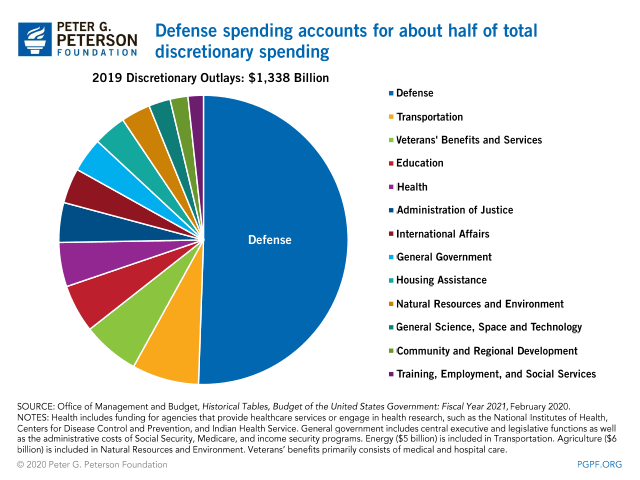The expenditures of the national budget are influenced by the demands of the country’s current state on a federal level and the GDP-related possibilities. However, the economic principle of opportunity cost constrains the assets utilization possibilities and requires an accurate distribution of finances across multiple sectors. The opportunity cost principle implies the cost of the choice of one of the alternatives that lead to the impossibility of using the spent resources for anything else besides the chosen variant.
The US budget spending is influenced by the level of importance of particular sectors to the country’s economy at a given time. According to the Peter G. Peterson Foundation (2020), the US GDP distribution is presented as follows (See Figure 1).

As the pie chart shows, the expenditures on health constitute less percentage than defense or transportation.
Given the information from the chart and the economic data stating that the health expenditures’ share in GDP is 17.4%, one should note that this percentage is insufficient when evaluated against other sectors. Indeed, according to Hartman et al. (2013), governmental health expenditures remain stable while personal health care payments increase, which is influenced by the increasing role of private health care facilities. Other economic sectors such as jobs and growth of income did not increase over time, which implies that the society is exposed to additional financial burdens related to health costs (Hartman et al., 2013). Thus, from the perspective of the principle of opportunity cost, the costs spent on health are insufficient due to the allocation of a substantial part of finances to defense and other non-health sectors. Medical expenditures should be viewed on an integrative level to incorporate both governmental and personal costs of health care.
References
Hartman, M., Martin, A. B., Benson, J., Catlin, A., & National Health Expenditure Accounts Team. (2013). National health spending in 2011: Overall growth remains low, but some payers and services show signs of acceleration. Health Affairs, 32(1), 87-99.
Peter G. Peterson Foundation. (2020). Discretionary spending breakdown [Data set]. Web.